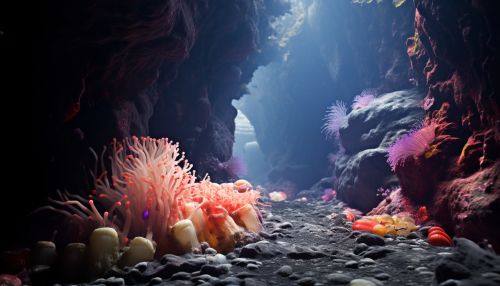The Ecology of Deep-Sea Vents and Chemosynthetic Ecosystems
Introduction
Deep-sea vents, also known as hydrothermal vents, are unique ecosystems found in the deep ocean, typically at depths of over 2,000 meters. These vents are characterized by the emission of geothermally heated water, rich in minerals and chemicals, which support a diverse array of life forms. The organisms inhabiting these ecosystems rely on chemosynthesis, a process that uses chemical energy from the vent fluids to produce food, rather than photosynthesis which is not possible in the deep-sea environment due to the absence of sunlight.
Ecology of Deep-Sea Vents
Deep-sea vents are home to a variety of organisms, from microscopic bacteria to larger animals such as tube worms, clams, and crabs. These organisms have adapted to survive in the extreme conditions of the deep sea, which include high pressure, low temperatures, and complete darkness.
Primary Producers
The base of the food chain in deep-sea vent ecosystems is formed by chemosynthetic bacteria. These bacteria utilize the chemicals in the vent fluids, particularly hydrogen sulfide, to produce organic matter through the process of chemosynthesis. This process is analogous to photosynthesis in terrestrial and shallow water ecosystems, but instead of using light energy, it uses chemical energy.
Secondary Consumers
Above the primary producers in the food chain are a variety of organisms that consume the chemosynthetic bacteria. These include filter-feeding organisms such as tube worms and clams, which have symbiotic relationships with the bacteria. The bacteria live inside the tissues of these animals and provide them with nutrients. In return, the animals provide the bacteria with a stable environment and access to the chemicals they need for chemosynthesis.


Tertiary Consumers
At the top of the food chain are predators such as crabs and octopuses, which feed on the filter-feeding organisms. These predators are adapted to the harsh conditions of the deep sea and are able to withstand the high pressures and low temperatures.
Chemosynthetic Ecosystems
Chemosynthetic ecosystems are not limited to deep-sea vents. They can also be found in other extreme environments where sunlight is not available for photosynthesis. These include cold seeps, where methane and other hydrocarbons seep out of the seafloor, and whale falls, where the carcass of a dead whale provides a temporary source of nutrients on the otherwise nutrient-poor deep-sea floor.
Cold Seeps
Like deep-sea vents, cold seeps are home to chemosynthetic bacteria, which form the base of the food chain. However, the chemical composition of the seep fluids is different from that of vent fluids, leading to differences in the types of bacteria and the organisms that feed on them.
Whale Falls
Whale falls occur when a whale dies and its carcass sinks to the deep-sea floor. The carcass provides a temporary but rich source of nutrients, leading to a burst of activity and the formation of a temporary ecosystem. Chemosynthetic bacteria play a key role in the decomposition of the whale carcass, and in turn provide food for a variety of other organisms.
Impact of Human Activities
Deep-sea vents and other chemosynthetic ecosystems are threatened by human activities such as deep-sea mining and fishing. Deep-sea mining, in particular, poses a significant threat as it can directly destroy vent ecosystems. There is also concern about the potential for pollution and disturbance of the deep-sea environment.
Conservation Efforts
Efforts are being made to conserve deep-sea vents and other chemosynthetic ecosystems. These include the establishment of marine protected areas and the development of regulations for deep-sea mining. However, these efforts are challenged by the lack of knowledge about these ecosystems and the difficulties in monitoring and enforcing protections in the deep sea.
